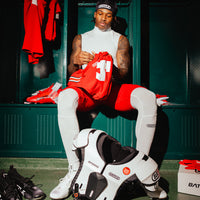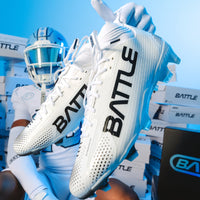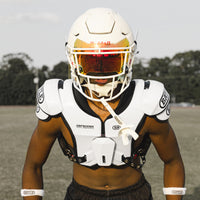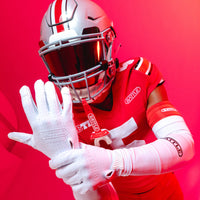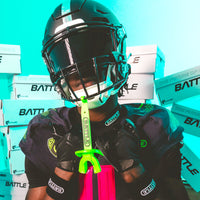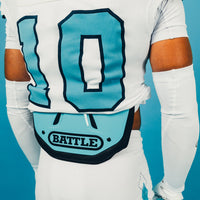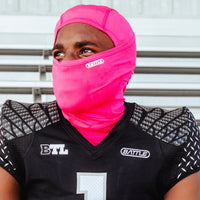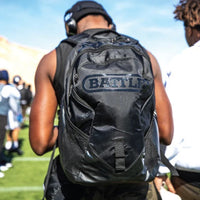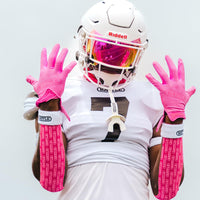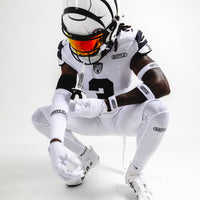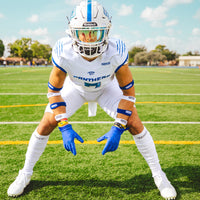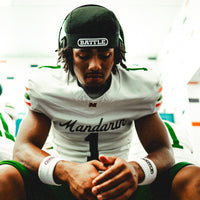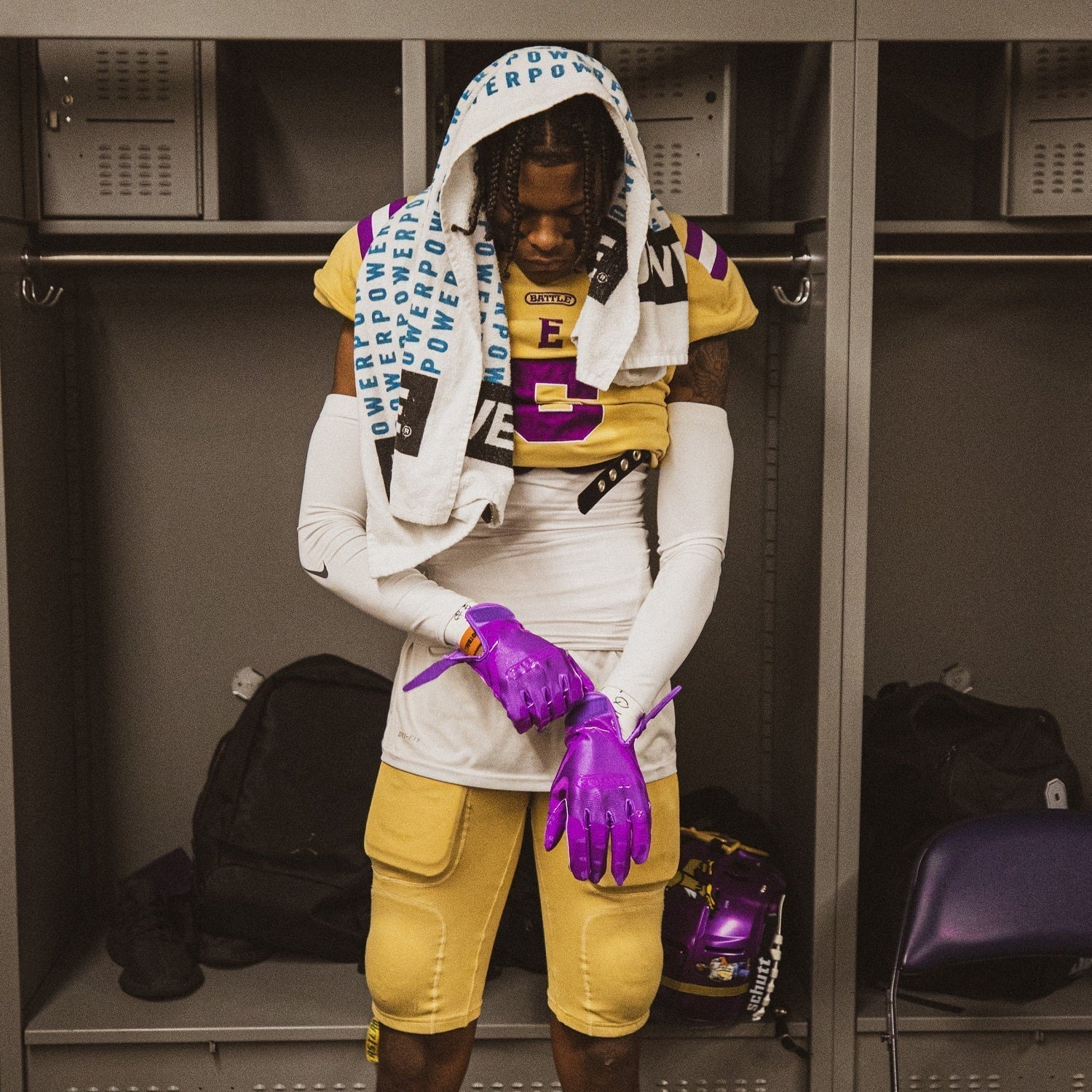Whether you’re brand new to the game or starting your first season with a real team, figuring out how to put on football gear the right way is one of the most important steps in getting game-day ready.
Properly suiting up isn’t just about looking like a pro; it’s about staying safe, feeling comfortable, and performing your best every play. This beginner-friendly, step-by-step guide breaks it all down so you can build your football routine with confidence.
From your compression layer to the final piece of protective gear, here’s how to put on football equipment like a seasoned athlete.
Step 1: Start with a Compression Layer

A compression shirt and compression shorts are the first things you’ll put on, and they do a lot more than just look sleek under your pads. That’s why you’ll want to make sure you choose the right material and fit. When it comes to what to wear under football pads, this compression base layer is the foundation of both comfort and performance.
Choose Moisture-Wicking Materials
Imagine your first scrimmage in full pads on a hot day. Without moisture-wicking compression gear, it won’t be long before you’re feeling sticky and uncomfortable. Even worse? Sweat-soaked fabric can lead to chafing.
That’s why your compression shirt and shorts or tights should be made from breathable, sweat-repelling materials such as polyester blends or technical fabrics that pull moisture away from the skin, keeping you dry and comfortable all game long.
Bonus tip: If you’re playing in cooler weather, consider lightweight thermal compression as your base. It adds warmth without bulk and still wicks moisture away. Some players also wear thin sleeves or compression neck gaiters, depending on the weather and team uniform.
Ensure a Snug but Flexible Fit
Your compression layer should fit like a second skin. That means it should be close-fitting enough to support your core, reduce muscle fatigue, and prevent gear from shifting.
Basically, it needs to stay in place during high-impact plays but still allow your body to move freely. You want a snug fit that supports your muscles without squeezing or cutting off circulation.
Step 2: Put on Football Pants with Pads
Next up: football pants, which include built-in or insertable pads to protect some of the most vulnerable areas, like your thighs, hips, knees, and tailbone.
Check That All Pads Are Secure
Whether you’re working with pants that have integrated pads or ones where you slide pads into pockets, double-check that each pad sits directly over the area it’s meant to protect.
Make sure they’re not twisted, bunched up, or sliding out of place, especially around the knees and tailbone. Any pad that slides out of position during movement isn’t doing its job and could leave you vulnerable.
Lace or Strap Pants Tightly at the Waist
Once the pads are in place, fasten your pants securely at the waist. A good fit ensures the pants and pads stay put, no matter how intense the play gets.
Depending on your pant style, use the built-in laces, belt, or Velcro strap, and make sure everything feels snug without digging into your skin.
Step 3: Slide on Shoulder Pads

Now it’s time for one of the most important pieces of protection on the field: shoulder pads. These not only shield your shoulders and chest from impact but also serve as the foundation for your jersey.
Align Pads with Shoulder Bones
Slip the pads over your head and make sure they rest evenly over the top of your shoulders. When it comes to football shoulder pad sizing, the shoulder caps should align directly with your shoulder joints, not hanging too far over or sitting too far inward.
When properly positioned, the pads should stay in place (even when you lift your arms).
Fasten Straps Under the Arms
Once the pads are in position, use the straps or buckles under the arms to tighten them. The fit should be secure but not restrictive. This means you should be able to move, breathe, and rotate your arms comfortably without the pads sliding around.
A well-fitted pad set provides coverage and stays stable, even during lateral motion and arm swings.
Step 4: Put on the Jersey

With your pads in place, it’s time to throw on your football jersey. This top layer keeps everything held together while adding your team's colors and your number to your game-day look.
Pull Down Evenly Over Pads
Slide the jersey over your head and work it down over the shoulder pads evenly, smoothing out any wrinkles or bunches as you go. This might take a little effort, especially if the jersey is fitted, but it’s important to ensure a snug, secure fit.
Tuck the Jersey into Your Pants if Needed
Some leagues or teams may require you to tuck your jersey into your football pants for a cleaner, more professional appearance. Even if it’s not required, some players find that a tucked jersey stays in place better and prevents distractions on the field.
Step 5: Secure the Helmet

Your football helmet is your primary line of defense against head injuries, so getting the right fit is absolutely critical. A helmet that fits well should feel snug and secure without causing discomfort.
Adjust the Chin Strap and Padding
Place the helmet over your head and tighten the chin strap evenly on both sides. You may also need to adjust the internal padding or air bladder (if your helmet has one) to get the right fit.
A proper setup will center the helmet on your head and allow the facemask to sit just above your eyebrows.
Check for Movement
Once everything is fastened, move your head around (make sure to shake it side to side) and nod up and down.
Your helmet shouldn’t wobble, rotate, or slide. If it does, tighten the straps or adjust the padding. A helmet that fits correctly stays in place and protects you on every play.
Step 6: Insert the Mouthguard

Mouthguards protect more than just your teeth; they help distribute impact forces and diminish the risks of concussions. There are several types of football mouthguards to choose from, including boil-and-bite, custom-fitted, and strapped or strapless options—each offering varying levels of fit and protection.
Use a Boil-and-Bite for Best Fit
To achieve the best fit, choose a boil-and-bite mouthguard. Soften it in hot water, bite down firmly while it cools, and you’re left with a form-fitting mouthpiece that molds to your teeth and jaw.1
This method gives you custom comfort and better retention compared with standard one-size-fits-all models.
Attach It to the Helmet (Connected Strap Mouthguards)
If you have a connected strap mouthguard, attach it to the helmet. This keeps it from falling out during play and ensures you can quickly insert it between snaps. Practice inserting and removing it one-handed (game situations aren’t always two-handed friendly).
If you have braces, make sure you understand how to wear a mouthguard with braces—you’ll need a specially designed mouthguard that offers extra room and protection for brackets and wires.
Step 7: Add Gloves and Accessories

Once the big protective pieces are in place, it’s time to personalize your gear and add enhancements that boost your game.
Choose Grip-Enhancing Gloves
If you handle the ball (like receivers, running backs, or DBs), football gloves are essential. Go for gloves with tacky palms and snug wrists to maximize control and minimize slippage.
Choose a flex-fit model that stays secure but doesn’t hamper wrist movement during catches or stiff arms.
Optional Protection
Some players like to add layers such as football sleeves, padded girdles, or visors on helmets. Visors not only protect your eyes but also give your helmet a sleek look. Meanwhile, arm sleeves provide extra coverage and can help with muscle warmth and recovery.
No matter what you add to your look, make sure any accessories comply with your league's rules.
Quick Fit Check
Before heading onto the field, do a final check.
First, put on your gloves and try opening and closing your hands (a.k.a., the fist test) to ensure they’re snug but not tight.2 Learn more about how football gloves should fit in our blog.
Then, put on your mouthguard and helmet. Shake your head and move around to make sure everything remains snug but comfortable. If anything feels off, it’s better to make adjustments now than when you're out on the field.
Bonus: Practice Your Gear Routine
Repetition builds muscle memory. The more often you suit up with proper technique, the harder it is to mess up next time, especially before a game or practice.
- Practice at home – Put on your gear after school or during warm-ups so you become familiar with every buckle, strap, and piece of padding.
- Include teammates – Set up a pre-game gear line where teammates help each other check fit. You might spot flaws in someone else’s setup that you wouldn’t notice on your own.
- Double-check before games – Carry a checklist that includes everything you need, from the compression layer to your mouthguard and gloves. Going through a sequence helps reduce mistakes under time pressure.
Making your gear routine second nature means you’ll suit up faster and walk onto the field knowing everything’s in place.

Why Proper Gear Fit Matters
Understanding how to put on football gear effectively goes beyond convenience; it’s about protection and performance.
- Safety first – Whether it’s distributing impact across pads or preventing helmet rotation on a hit, properly worn equipment reduces injury risk.
- Comfort and endurance – Gear that fits well won’t dig, pinch, or shift mid-play, which keeps distractions minimal and energy focused on the game.
- Performance enhancement – When gear fits flawlessly, you move better, see clearer, perform confident plays, and stay faster on the field.
- Gear longevity – Taking the time to put everything on properly helps reduce wear and tear so straps don’t rip prematurely, pads don’t shift and crease, and helmets maintain their protective properties longer.
Plus, when you look the part and feel locked in, you’re stepping onto the field with the mindset of a pro—and that confidence can be a game-changer.
Gear Up with Battle Sports Football Equipment
Learning how to put on football gear the right way is an essential step for every football player, whether you’re new or experienced. Each piece, from compression base layers to gloves and mouthguards, plays a critical role in keeping you safe, comfortable, and game day-ready—and that’s especially true for high-quality gear.
At Battle Sports, we design football gear and football apparel with players like you in mind. Explore our full collection and find the high-quality, beginner-ready equipment you need to stay safe, feel confident, and perform your absolute best.
Sources:
- Colgate. What Are Sports Mouth Guards? https://www.colgate.com/en-us/oral-health/dental-emergencies-and-sports-safety/what-are-sports-mouth-guards
- High School Football America. Do Your Football Gloves Fit Properly? https://highschoolfootballamerica.com/do-your-gloves-fit-properly/



